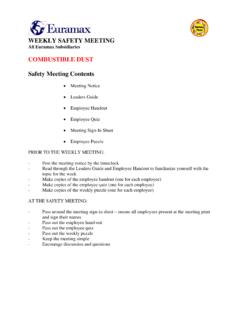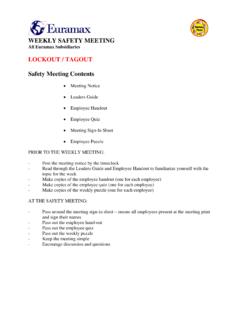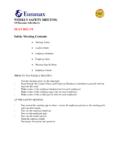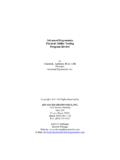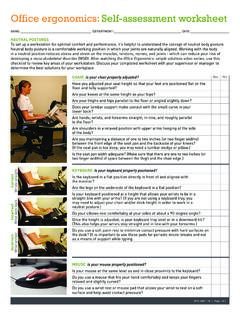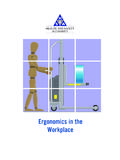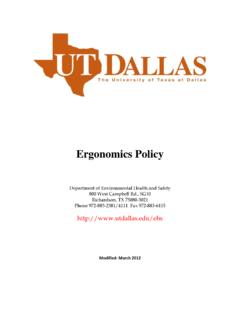Transcription of WEEKLY SAFETY MEETING REPETITIVE MOTION …
1 WEEKLY SAFETY MEETING All Euramax Subsidiaries REPETITIVE MOTION INJURIES / ERGONOMICS SAFETY MEETING Contents MEETING Notice Leaders Guide Employee Handout Employee Quiz MEETING Sign-In Sheet Employee Puzzle PRIOR TO THE WEEKLY MEETING : - Post the MEETING notice by the timeclock - Read through the Leaders Guide and Employee Handout to familiarize yourself with the topic for the week - Make copies of the employee handout (one for each employee) - Make copies of the employee quiz (one for each employee) - Make copies of the WEEKLY puzzle (one for each employee) AT THE SAFETY MEETING : - Pass around the MEETING sign-in sheet ensure all employees present at the MEETING print and sign their names - Pass out the employee hand-out - Pass out the employee quiz - Pass out the WEEKLY puzzle - Keep the MEETING simple - Encourage discussion and questions WEEKLY SAFETY MEETING NOTICE THIS WEEK, OUR SAFETY MEETING WILL COVER REPETITIVE MOTION INJURIES/ERGONOMICS TIME: _____ DATE: _____ PLACE.
2 _____ WEEKLY SAFETY MEETING All Euramax Subsidiaries Leaders Guide Page 1 REPETITIVE MOTION INJURIES/ERGONOMICS EURAMAX PROCEDURE REFERENCE: : Lifting Procedure MEETING OBJECTIVE: REPETITIVE MOTION injury (RMI) is a serious health and SAFETY problem that affects millions of people. Once a worker is stricken with this type of injury, he or she may lose a great deal of time from the job while recovering and receiving treatment. There's even the possibility that the worker might have to stop performing some tasks permanently. Prevention is clearly the best cure for this type of injury. The purpose of this MEETING is to inform employees about the dangers of REPETITIVE MOTION injury and show them the steps they can take to prevent it.
3 Ergonomics is the applied science of equipment design and arrangement, intended to maximize productivity by reducing operator fatigue and discomfort. Injuries related to ergonomics are those caused by over-use, impact, vibration, repetition, forceful exertion. Largely injuries of the musculoskeletal systems of the body, these injuries include carpal tunnel syndrome, bursitis, tenosynovitis, tendinitis and others. These problems affect the muscles, ligaments and tendons as well as the nerves and blood vessels. MEETING PREPARATION: Read the Euramax procedure, understand the contents, and ensure compliance. Make a list of jobs at your facility that involve REPETITIVE MOTION . Be prepared to discuss methods for avoiding injury.
4 Use a flip chart during the discussion to write key points and employee responses. This technique visually reinforces your instruction. MATERIALS CHECKLIST: List of jobs involving REPETITIVE MOTION Flip chart and marking pens WEEKLY SAFETY MEETING All Euramax Subsidiaries Leaders Guide Page 2 REPETITIVE MOTION INJURIES/ERGONOMICS MEETINGINTRODUCTION While you're doing your job or completing tasks at home, you may be performing certain actions and movements over and over. If you're also using excessive force, failing to condition or relax your muscles sufficiently, or completing that task in a work area that hasn't been adjusted properly, you may be setting yourself up for a REPETITIVE MOTION injury.
5 Today, you'll learn what causes REPETITIVE MOTION injury--known as RMI--and the steps you can take to prevent it. REPETITIVE MOTION injury is common among workers who consistently perform tasks that require them to repeat the same movements over and over. The pain associated with REPETITIVE MOTION injury most often affects the tendons, nerves, and muscles of the hands, wrists, elbows, arms, neck, and lower back. Estimates of the costs associated with work-related RMI s range from 13 billion to $54 billion per year. According to the Bureau of Labor Statistics, about one-third of all occupational injuries and illnesses are due to overexertion or REPETITIVE MOTION . Numerous case studies show that increased ergonomics-oriented awareness, training, and hazard reduction will reduce injuries, lost work time, and associated costs.
6 REPETITIVE MOTION injury isn t new. It used to be referred to as washerwoman s thumb or telegraph operator s cramp. But today, with the spread of automation and increased production demands, the incidence of this syndrome has rapidly increased. Today, hundreds of thousands of cases are reported every year. If the pain associated with this injury is ignored, permanent damage can result. Fortunately, treatment can help and establishing better work habits can prevent similar problems in the future. Ergonomics is the applied science of equipment design and arrangement, intended to maximize productivity by reducing operator fatigue and discomfort. Injuries related to ergonomics are those caused by over-use, impact, vibration, repetition, forceful exertion.
7 Largely injuries of the musculoskeletal systems of the body, these injuries include carpal tunnel syndrome, bursitis, tenosynovitis, tendinitis and others. These problems affect the muscles, ligaments and tendons as well as the nerves and blood vessels. Ergonomics-related injuries can be reduced by improvements in equipment and work practices. An example is work in a nursing home, where an employee is more likely to be injured than is a worker in a coal mine or steel mill. The most common injury for a nursing home worker is back injury caused by lifting patients. These injuries can be reduced significantly by use of mechanical lifting and transfer devices for moving patients in and out of beds and chairs.
8 WEEKLY SAFETY MEETING All Euramax Subsidiaries Leaders Guide Page 3 REPETITIVE MOTION INJURIES/ERGONOMICS Question: What are some common causes of REPETITIVE MOTION injury? Answer: Performing tasks that require you to repeat the same movements over and over Using a chair that s improperly adjusted Completing tasks in an improperly arranged work area Neglecting to vary tasks Varying one REPETITIVE job with another that uses similar motions Using excessive force when performing a REPETITIVE task Twisting Neglecting to rest your body sufficiently when performing REPETITIVE work Question: What are some of the symptoms of REPETITIVE MOTION injury?
9 Answer: Difficulty gripping objects A tingling or burning sensation in the affected area Numbness Pain that occurs when you re trying to sleep Question: You should never ignore these symptoms, or related symptoms. Failure to take action when REPETITIVE MOTION injury exists can lead to several serious physical problems. What are some of these problems? Answer: Loss of muscle strength Severe pain in the affected area that may extend to other areas Nerve damage WEEKLY SAFETY MEETING All Euramax Subsidiaries Leaders Guide Page 4 REPETITIVE MOTION INJURIES/ERGONOMICS Permanent loss of sensation and muscle control Question: How can you protect yourself against ergonomics-related injury?
10 Answer: Pay attention to how you do your job. Be aware of long reaches for materials, REPETITIVE motions and twisting movements while carrying an object. Arrange your work station for the best placement of tools and supplies. Things you use frequently should be within easy reach. Infrequently-used items should be stored out of your way. Use mechanical equipment for lifting and moving items whenever possible. An electrical lift table and a hand cart can save your back. Talk to your supervisor if you see a need for this equipment. Use good posture. Sit, stand and walk with your back relatively straight, while maintaining the natural curves at the neck and lower back. Question: How can good work habits help prevent REPETITIVE MOTION injury?
